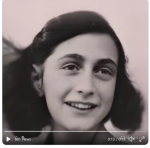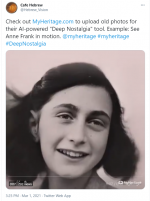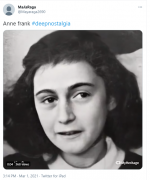
The representation of the Holocaust in an age of artificial intelligence. How deepfake technology makes Anne Frank feel close in a non-transparent way.
Our need for moving images
The past is over, it has been consigned to history – yet this dichotomy rests on a somewhat naive view. Our constant dealings with the past only confirm the extent to which we cannot and do not want to let go of certain historical experiences. History lives on, based on our sources and our present-day questions and interests. This is especially true of recent 20th-century history, and of the Second World War and the Holocaust; events that had a major impact and that left various traces. The recent rise of artificial intelligence has prompted new questions in this regard.
We want an accessible past, a past that is close to us. A past that satisfies our 21st-century desires, and that therefore needs to be accessible and appealing. A past that is neither abstract nor remote. Recognisable individuals can embody that past and help us to imagine it. That is why we identify with Anne Frank, for example, a world-famous icon of the Holocaust. We know about her diary and we are equally familiar with several portrait photos of her. Around 2009, a video surfaced, made on 22 July 1941, in which Anne appears for a few seconds:
The grainy black-and-white images are anything but polished, but they are authentic. These images have been viewed more than 6 million times on YouTube alone; there is undeniably a great need for moving images, for a moving person of flesh and blood. But this could not sate the appetite for moving images of Anne.
Anne Frank meets artificial intelligence
The genealogical website MyHeritage.com, an Israeli commercial platform, recently offered an app that allows photos to be transformed into moving images for free, with the aid of artificial intelligence. According to the website, the app was used 10 million times in a single week. Not only were photos of deceased grandfathers and grandmothers animated, but also numerous celebrities from times gone by were re-presented in this way.
It did not take long for photos of Anne Frank to be edited. The first site to show a moving version of Anne Frank was probably the American website Reddit.
The results were described as ‘a little uncanny’, but the editor (that is to say, the uploader who used the app) thought the images reflected ‘the humanity of Anne’, emphasising ‘what she was: a little girl, a child who was legally murdered’. On 1 March, the first results also appeared on Twitter; short videos lasting barely fifteen seconds, in which Anne’s head turns, her eyes move, and her mouth also appears to move. The explanation reads: ‘See Anne Frank in motion’:
A second video, in which Anne Frank was animated as a historical character, appeared on Twitter the same day but was based on a different photo:
It is strange, and even somewhat alarming, to see someone who is mainly known for her tragic fate depicted in such a clear and seemingly lively way on screen. Evidently, however, not even this animated representation brought her close enough to 21st-century standards, because an animated video then appeared on YouTube that was based on a colour photo:
In all cases, the photos that were used as the starting point for the videos were taken before Anne went into hiding with her sister and parents, and thus before they ended up in the camps. In that respect, they depict an Anne who was unaware, both of the experiences that would bring her so much posthumous fame and of the ways in which memories of her would be interpreted.
The need for visual literacy
The rapid rise of artificial intelligence, especially low-threshold access to this technology, not only confirms the great interest in the Holocaust, but it also changes our relationship with it, and with (images of) individual victims in particular. When it appears in a new context, the form of an image changes. If a historical photo is animated with the implication or expectation that it is authentic, it becomes a fake video. In the examples above, the deepfake images could still be recognised from the MyHeritage logo at the bottom right of the screen, provided the viewer paid attention to this. Anyone who knows how widespread and user-friendly image editing technology has become, however, will realise that if so desired, it takes little effort to make such references to contemporary intervention virtually invisible. Image editing as such is not new, but it will probably become increasingly difficult to spot.
At the same time, these new opportunities appeal to people; people for whom the past suddenly seems much less remote and who are genuinely touched by it. Are they and will they remain aware of the technological adaptations of the original image? Will that play a role in their assessment? This makes it difficult to give a straightforward assessment of what is still optimistically known as #DeepNostalgia. Moreover, how will historians, heritage specialists and others manage these options, opportunities that could once only be dreamed of? Will museums and memorial centres ‘lag behind’ if cyberspace is full of images that appear less static and distanced than the ones they show? The importance of visual material in the transfer of historical experiences and stories does not seem to be diminishing at all; on the contrary. But there is an urgent and growing need for critical visual literacy, which can distinguish the real from the unreal, yet acknowledges the need for closeness.
By: Kees Ribbens


